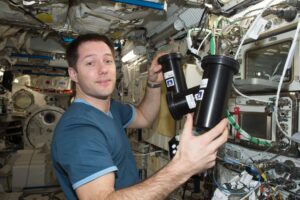
When it comes to exploring Mars, the surface is just the beginning. NASA’s Perseverance rover is not only collecting core samples but also grinding into Martian rocks to uncover secrets buried beneath the dusty surface. On June 3, Perseverance targeted a particularly stubborn rock named “Kenmore,” scraping away its surface to reveal the mysteries within.
Equipped with a sophisticated set of tools, the rover examined Kenmore’s minerals and geological features. This rock marks the 30th in a series of studies, beginning with a two-inch-wide abrasion patch.
Digging Deeper into Martian Geology
Professor Ken Farley, a noble gas isotope geochemist at Caltech and deputy project scientist for the Perseverance mission, described Kenmore as “a weird, uncooperative rock.”
“Visually, it looked fine – the sort of rock we could get a good abrasion on and perhaps, if the science was right, perform a sample collection,” said Professor Farley. “But during abrasion, it vibrated all over the place and small chunks broke off. Fortunately, we managed to get just far enough below the surface to move forward with an analysis.”
Perseverance’s gold-colored abrading bit, captured by the Mastcam-Z instrument, is central to this exploration. Scientists aim to reach beyond the weathered, dusty exteriors of Martian rocks to expose their unaltered interiors, providing a clearer picture of their composition.
Innovative Techniques for Mars Exploration
Previous Mars missions, like Spirit and Opportunity, used spinning grinders with brushes, while Curiosity employed wire bristles to clean rock surfaces. Perseverance, however, utilizes a more advanced and efficient approach.
Instead of brushes, Perseverance employs the gaseous Dust Removal Tool (gDRT), which blasts nitrogen gas to clear debris post-grinding.
“We use Perseverance’s gDRT to fire a 12-pounds-per-square-inch (about 83 kilopascals) puff of nitrogen at the tailings and dust that cover a freshly abraded rock,” explained Kyle Kaplan, a robotic engineer at NASA’s Jet Propulsion Laboratory. “Five puffs per abrasion – one to vent the tanks and four to clear the abrasion. And gDRT has a long way to go. Since landing at Jezero Crater over four years ago, we’ve puffed 169 times. There are roughly 800 puffs remaining in the tank.”
This method avoids physical contact with the rock, reducing the risk of Earth contaminants. Once the dust is cleared, Perseverance uses advanced sensors, including the WATSON camera and SuperCam, to analyze the rock’s composition through laser pulses and spectrometry.
Revealing Mars’ Geological Diversity
Team member Cathy Quantin-Nataf from the University of Lyon noted that SuperCam’s observations revealed clay minerals within Kenmore, indicative of ancient Martian environments.
“SuperCam made observations in the abrasion patch and of the powdered tailings next to the patch,” said Quantin-Nataf. “The tailings showed us that this rock contains clay minerals, which contain water as hydroxide molecules bound with iron and magnesium – relatively typical of ancient Mars clay minerals. The abrasion spectra gave us the chemical composition of the rock, showing enhancements in iron and magnesium.”
Further analysis by SHERLOC and PIXL instruments confirmed the presence of feldspar and identified manganese hydroxide minerals, a first for the mission.
Looking Ahead: Mars Exploration’s Future
With Kenmore’s analysis complete, Perseverance is set to explore new areas along Jezero Crater’s edge. Farley emphasized the importance of understanding Martian rock diversity for future missions.
“One thing you learn early working on Mars rover missions is that not all Mars rocks are created equal,” Farley stated. “The data we obtain now from rocks like Kenmore will help future missions so they don’t have to think about weird, uncooperative rocks.”
On June 19, Perseverance set a new personal record, traveling 1,348 feet (411 meters) autonomously, showcasing its ability to efficiently navigate Mars’ challenging terrain.
“Perseverance drove 4½ football fields and could have gone even farther, but that was where the science team wanted us to stop,” said Camden Miller, a rover driver at JPL. “And we absolutely nailed our stop target location.”
As Perseverance continues its mission, each discovery contributes to a deeper understanding of Mars, paving the way for future explorations and potential human habitation.







